2024人教版高中英语选择性必修第三册同步练习题--UNIT 1 Part 3 Using Language, Assessing Your Progress & Video Time(答案与解析)
文档属性
| 名称 | 2024人教版高中英语选择性必修第三册同步练习题--UNIT 1 Part 3 Using Language, Assessing Your Progress & Video Time(答案与解析) | 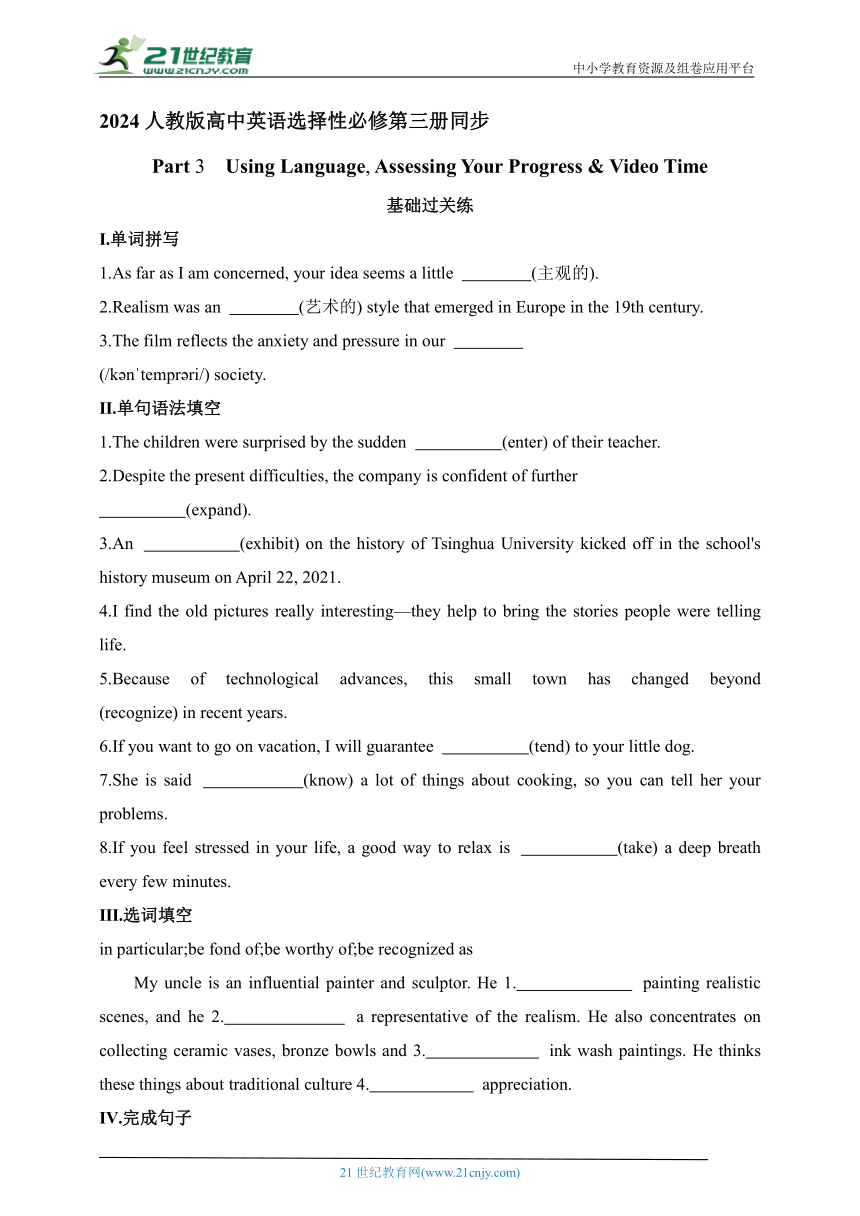 | |
| 格式 | docx | ||
| 文件大小 | 1.0MB | ||
| 资源类型 | 试卷 | ||
| 版本资源 | 人教版(2019) | ||
| 科目 | 英语 | ||
| 更新时间 | 2023-10-18 09:40:29 | ||
图片预览

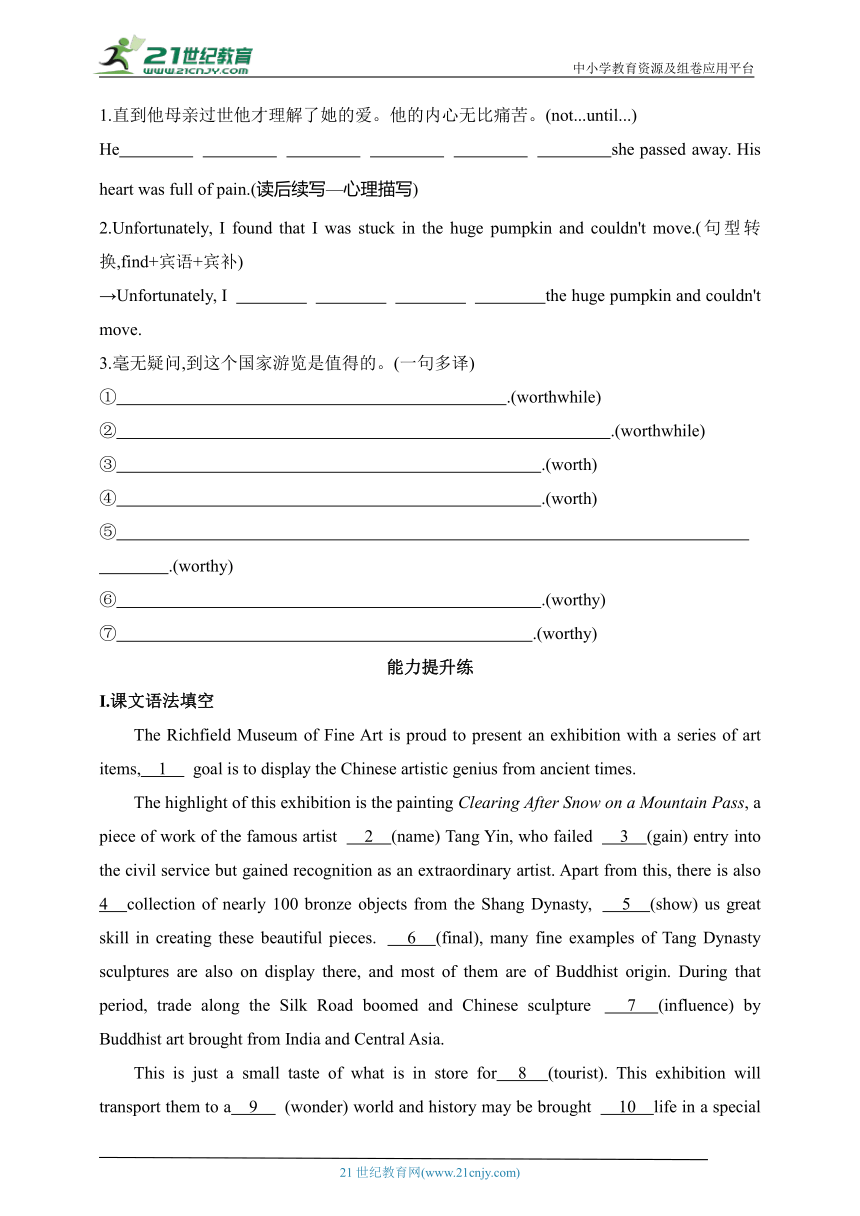
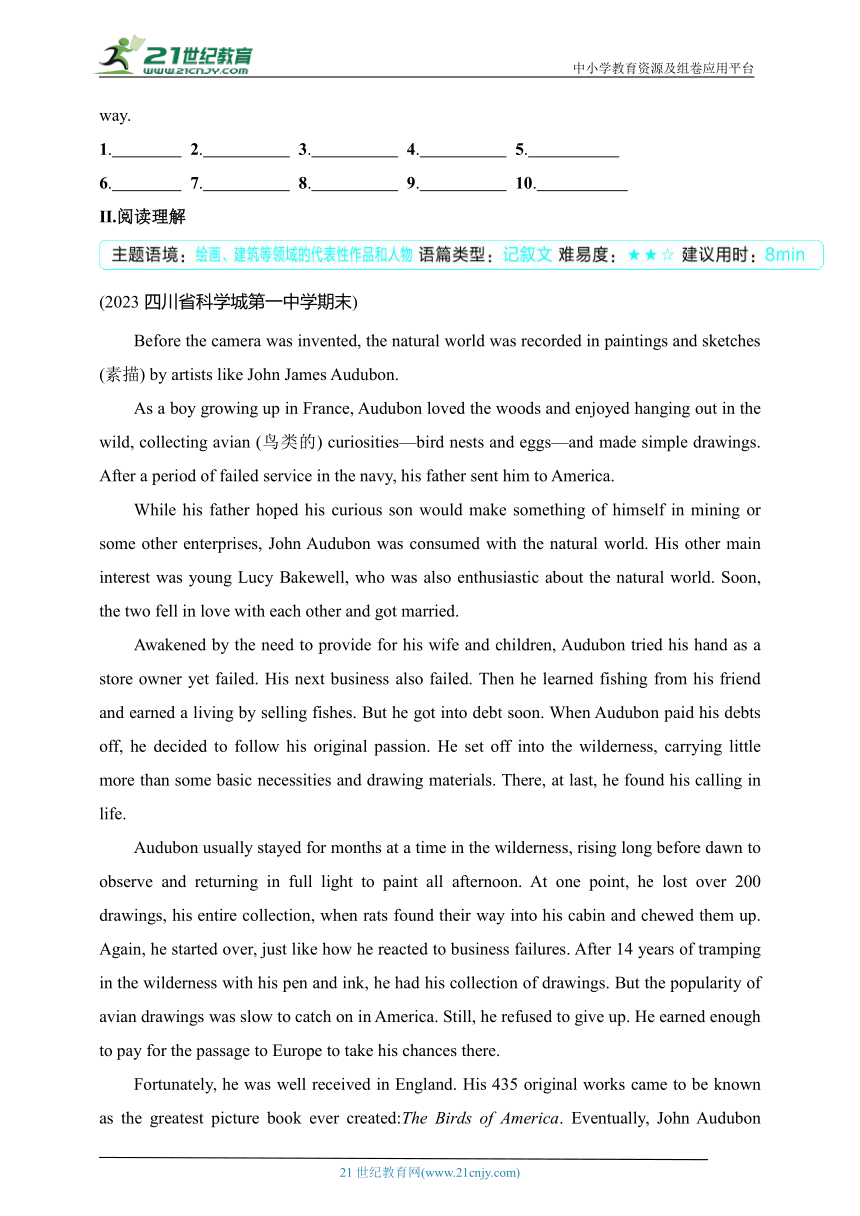
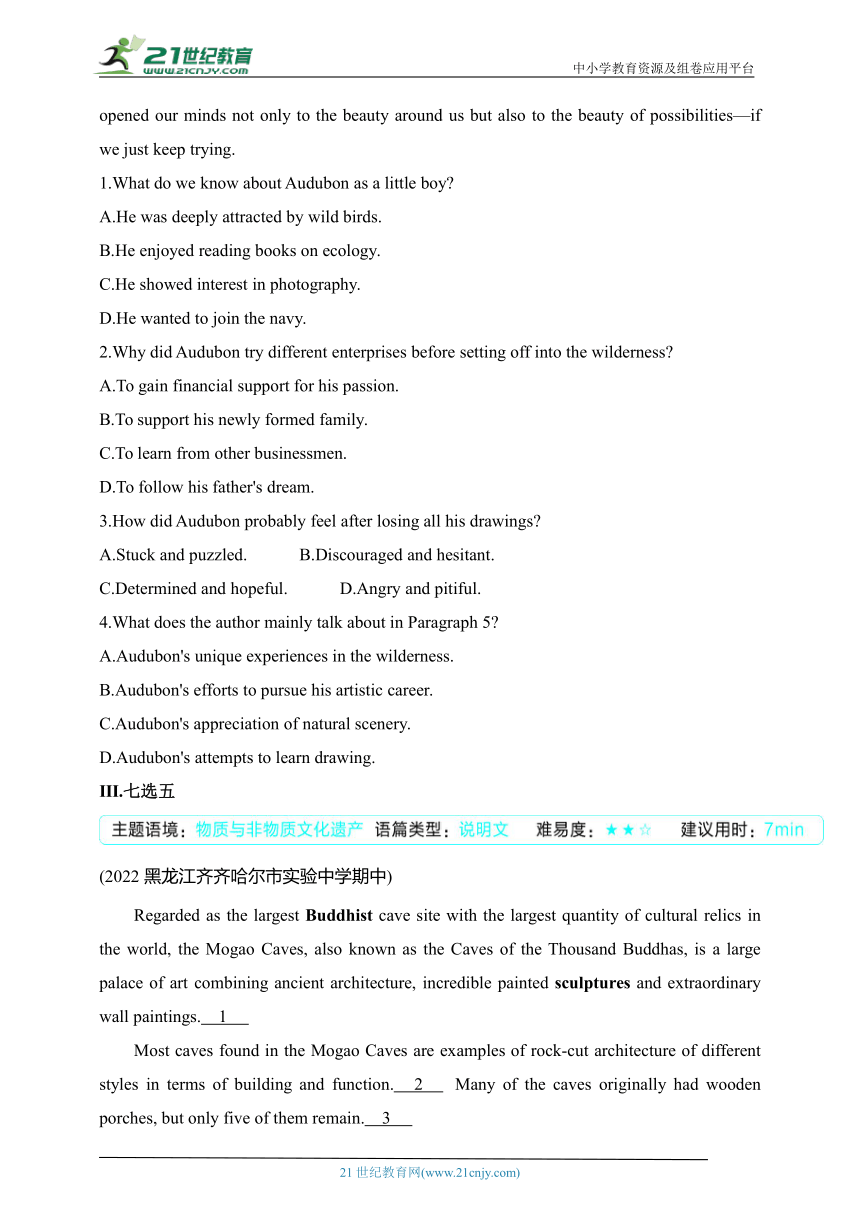
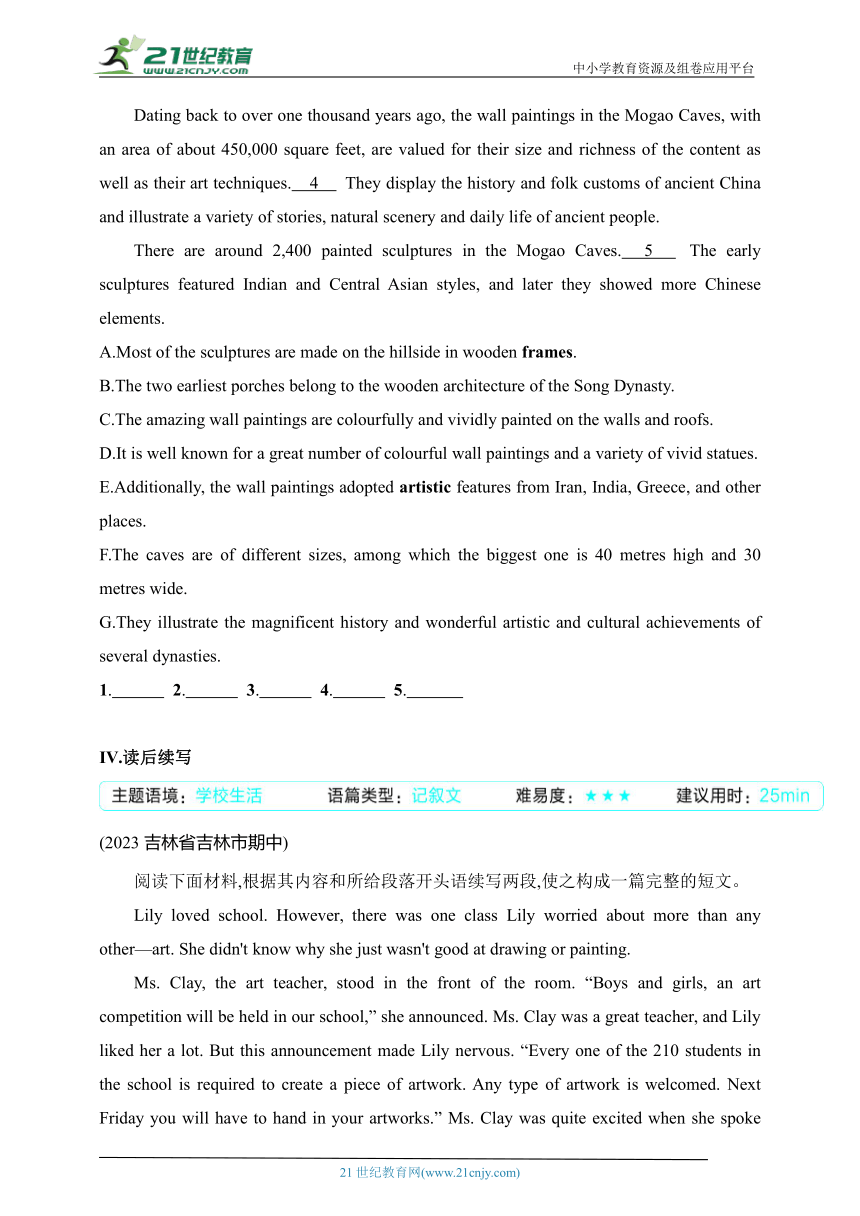
文档简介
中小学教育资源及组卷应用平台
2024人教版高中英语选择性必修第三册同步
Part 3 Using Language, Assessing Your Progress & Video Time
基础过关练
Ⅰ.单词拼写
1.As far as I am concerned, your idea seems a little (主观的).
2.Realism was an (艺术的) style that emerged in Europe in the 19th century.
3.The film reflects the anxiety and pressure in our
(/k n tempr ri/) society.
Ⅱ.单句语法填空
1.The children were surprised by the sudden (enter) of their teacher.
2.Despite the present difficulties, the company is confident of further
(expand).
3.An (exhibit) on the history of Tsinghua University kicked off in the school's history museum on April 22, 2021.
4.I find the old pictures really interesting—they help to bring the stories people were telling life.
5.Because of technological advances, this small town has changed beyond (recognize) in recent years.
6.If you want to go on vacation, I will guarantee (tend) to your little dog.
7.She is said (know) a lot of things about cooking, so you can tell her your problems.
8.If you feel stressed in your life, a good way to relax is (take) a deep breath every few minutes.
Ⅲ.选词填空
in particular;be fond of;be worthy of;be recognized as
My uncle is an influential painter and sculptor. He 1. painting realistic scenes, and he 2. a representative of the realism. He also concentrates on collecting ceramic vases, bronze bowls and 3. ink wash paintings. He thinks these things about traditional culture 4. appreciation.
Ⅳ.完成句子
1.直到他母亲过世他才理解了她的爱。他的内心无比痛苦。(not...until...)
He she passed away. His heart was full of pain.(读后续写—心理描写)
2.Unfortunately, I found that I was stuck in the huge pumpkin and couldn't move.(句型转换,find+宾语+宾补)
→Unfortunately, I the huge pumpkin and couldn't move.
3.毫无疑问,到这个国家游览是值得的。(一句多译)
① .(worthwhile)
② .(worthwhile)
③ .(worth)
④ .(worth)
⑤ .(worthy)
⑥ .(worthy)
⑦ .(worthy)
能力提升练
Ⅰ.课文语法填空
The Richfield Museum of Fine Art is proud to present an exhibition with a series of art items, 1 goal is to display the Chinese artistic genius from ancient times.
The highlight of this exhibition is the painting Clearing After Snow on a Mountain Pass, a piece of work of the famous artist 2 (name) Tang Yin, who failed 3 (gain) entry into the civil service but gained recognition as an extraordinary artist. Apart from this, there is also 4 collection of nearly 100 bronze objects from the Shang Dynasty, 5 (show) us great skill in creating these beautiful pieces. 6 (final), many fine examples of Tang Dynasty sculptures are also on display there, and most of them are of Buddhist origin. During that period, trade along the Silk Road boomed and Chinese sculpture 7 (influence) by Buddhist art brought from India and Central Asia.
This is just a small taste of what is in store for 8 (tourist). This exhibition will transport them to a 9 (wonder) world and history may be brought 10 life in a special way.
1. 2. 3. 4. 5.
6. 7. 8. 9. 10.
Ⅱ.阅读理解
(2023四川省科学城第一中学期末)
Before the camera was invented, the natural world was recorded in paintings and sketches (素描) by artists like John James Audubon.
As a boy growing up in France, Audubon loved the woods and enjoyed hanging out in the wild, collecting avian (鸟类的) curiosities—bird nests and eggs—and made simple drawings. After a period of failed service in the navy, his father sent him to America.
While his father hoped his curious son would make something of himself in mining or some other enterprises, John Audubon was consumed with the natural world. His other main interest was young Lucy Bakewell, who was also enthusiastic about the natural world. Soon, the two fell in love with each other and got married.
Awakened by the need to provide for his wife and children, Audubon tried his hand as a store owner yet failed. His next business also failed. Then he learned fishing from his friend and earned a living by selling fishes. But he got into debt soon. When Audubon paid his debts off, he decided to follow his original passion. He set off into the wilderness, carrying little more than some basic necessities and drawing materials. There, at last, he found his calling in life.
Audubon usually stayed for months at a time in the wilderness, rising long before dawn to observe and returning in full light to paint all afternoon. At one point, he lost over 200 drawings, his entire collection, when rats found their way into his cabin and chewed them up. Again, he started over, just like how he reacted to business failures. After 14 years of tramping in the wilderness with his pen and ink, he had his collection of drawings. But the popularity of avian drawings was slow to catch on in America. Still, he refused to give up. He earned enough to pay for the passage to Europe to take his chances there.
Fortunately, he was well received in England. His 435 original works came to be known as the greatest picture book ever created:The Birds of America. Eventually, John Audubon opened our minds not only to the beauty around us but also to the beauty of possibilities—if we just keep trying.
1.What do we know about Audubon as a little boy
A.He was deeply attracted by wild birds.
B.He enjoyed reading books on ecology.
C.He showed interest in photography.
D.He wanted to join the navy.
2.Why did Audubon try different enterprises before setting off into the wilderness
A.To gain financial support for his passion.
B.To support his newly formed family.
C.To learn from other businessmen.
D.To follow his father's dream.
3.How did Audubon probably feel after losing all his drawings
A.Stuck and puzzled. B.Discouraged and hesitant.
C.Determined and hopeful. D.Angry and pitiful.
4.What does the author mainly talk about in Paragraph 5
A.Audubon's unique experiences in the wilderness.
B.Audubon's efforts to pursue his artistic career.
C.Audubon's appreciation of natural scenery.
D.Audubon's attempts to learn drawing.
Ⅲ.七选五
(2022黑龙江齐齐哈尔市实验中学期中)
Regarded as the largest Buddhist cave site with the largest quantity of cultural relics in the world, the Mogao Caves, also known as the Caves of the Thousand Buddhas, is a large palace of art combining ancient architecture, incredible painted sculptures and extraordinary wall paintings. 1
Most caves found in the Mogao Caves are examples of rock-cut architecture of different styles in terms of building and function. 2 Many of the caves originally had wooden porches, but only five of them remain. 3
Dating back to over one thousand years ago, the wall paintings in the Mogao Caves, with an area of about 450,000 square feet, are valued for their size and richness of the content as well as their art techniques. 4 They display the history and folk customs of ancient China and illustrate a variety of stories, natural scenery and daily life of ancient people.
There are around 2,400 painted sculptures in the Mogao Caves. 5 The early sculptures featured Indian and Central Asian styles, and later they showed more Chinese elements.
A.Most of the sculptures are made on the hillside in wooden frames.
B.The two earliest porches belong to the wooden architecture of the Song Dynasty.
C.The amazing wall paintings are colourfully and vividly painted on the walls and roofs.
D.It is well known for a great number of colourful wall paintings and a variety of vivid statues.
E.Additionally, the wall paintings adopted artistic features from Iran, India, Greece, and other places.
F.The caves are of different sizes, among which the biggest one is 40 metres high and 30 metres wide.
G.They illustrate the magnificent history and wonderful artistic and cultural achievements of several dynasties.
1. 2. 3. 4. 5.
Ⅳ.读后续写
(2023吉林省吉林市期中)
阅读下面材料,根据其内容和所给段落开头语续写两段,使之构成一篇完整的短文。
Lily loved school. However, there was one class Lily worried about more than any other—art. She didn't know why she just wasn't good at drawing or painting.
Ms. Clay, the art teacher, stood in the front of the room. “Boys and girls, an art competition will be held in our school,” she announced. Ms. Clay was a great teacher, and Lily liked her a lot. But this announcement made Lily nervous. “Every one of the 210 students in the school is required to create a piece of artwork. Any type of artwork is welcomed. Next Friday you will have to hand in your artworks.” Ms. Clay was quite excited when she spoke while Lily found herself sinking lower in her chair.
Lily spent the whole weekend working on her artwork, but she could not think of anything to do. On Monday, Lily felt discouraged, so after school Lily went to Ms. Clay's office and asked Ms. Clay if there was any possibility that she wouldn't enter the competition. “I understand it may worry and upset you, Lily,” Ms. Clay said. “But just remember: art isn't always painting or drawing. It can be something else. I am sure you can think of something very creative, and I can't wait to see it.”
When Lily arrived home, she sat at the table and was lost in thought. She thought of Ms. Clay's words. “Art isn't always painting or drawing. It can be something else.” Staring at her table, suddenly she was attracted to a pair of scissors and some paper.
注意:续写词数应为150左右。
Paragraph 1:
At that moment, a good idea struck her.
Paragraph 2:
On Friday, Lily went to school early with her artwork.
答案与分层梯度式解析
UNIT 1 ART
Part 3 Using Language, Assessing Your Progress & Video Time
基础过关练
Ⅰ.1.subjective 2.artistic 3.contemporary
Ⅱ.1.entry 考查名词。句意:孩子们对他们的老师突然进来感到惊讶。由空前的定冠词the和形容词sudden可知,设空处需填名词entry,意为“进入”。
2.expansion 考查名词。句意:尽管目前困难重重,但是这家公司对于进一步的扩展有把握。此处further为形容词,后需接名词expansion,意为“扩张;扩展”,作介词of的宾语。
3.exhibition 考查名词。句意:2021年4月22日,一场关于清华大学历史的展览在校史馆开幕。由设空处前的冠词An可知,此处应用名词,故填exhibition。
4.to 考查介词。句意:我觉得这些老照片很有趣——它们有助于使人们(当时)正在讲的故事鲜活起来。bring...to life使……鲜活起来。故填to。
5.recognition 考查名词。句意:由于技术的进步,近年来这座小城镇已经变得让人认不出来了。change beyond recognition意为“变得让人认不出来”。故填recognition。
6.to tend 考查动词不定式。句意:如果你想去度假,我会保证照顾你的小狗。guarantee to do sth.意为“保证做某事”。故填to tend。
7.to know 考查固定句型。句意:据说她知道很多关于烹饪的事情,所以你可以告诉她你的难题。“主语+be+过去分词+to do sth.”为固定句型。故填to know。
8.to take 考查动词不定式。句意:如果你在生活中感到焦虑不安,一个放松的好方法是每隔几分钟做一次深呼吸。当主语是aim、way、goal、duty、plan等时,常用不定式作表语。故填to take。
Ⅲ.1.is fond of 2.is recognized as 3.in particular
4.are worthy of
Ⅳ.1.didn't understand his mother's love until 2.found myself stuck in 3.①There is no doubt that it is worthwhile to visit this country ②There is no doubt that it is worthwhile visiting this country ③There is no doubt that this country is worth visiting ④There is no doubt that this country is worth a visit ⑤There is no doubt that this country is worthy of a visit ⑥There is no doubt that this country is worthy of being visited ⑦There is no doubt that this country is worthy to be visited
能力提升练
Ⅰ.1.whose 考查定语从句。设空处无提示词,与前面内容用逗号隔开,后面内容goal(目标)前缺定语,故推测设空处引导定语从句并在从句中作定语,所以用关系代词whose(=the exhibition's)。句意:里奇菲尔德艺术博物馆隆重地举办了一系列艺术品的展览,其目标是展示中国古代的艺术天赋。
2.named 考查过去分词。artist与name之间为逻辑上的被动关系,需用过去分词named作后置定语,修饰artist。故填named。
3.to gain 考查不定式。此处为固定搭配fail to do sth.“未能做某事”。故填to gain。
4.a 考查冠词。此处是固定结构a collection of...,意为“一批……”。故填a。
5.showing 考查现在分词。设空处前面是there be句型,句中已有谓语,故设空处应用非谓语动词,show与其逻辑主语(a collection of nearly 100 bronze objects)之间为主动关系,所以设空处需用现在分词showing作状语。
6.Finally 考查副词。设空处位于句首,提示词为形容词,后面有逗号,且后面的句子意思完整,所以设空处应用副词作状语,修饰整个句子。设空处位于句首,故填Finally。
7.was influenced 考查时态、语态及主谓一致。根据by Buddhist art可知,空格处需用被动语态,结合时间状语During that period及语境可知用一般过去时,主语为Chinese sculpture,表单数意义,故填was influenced。句意:在那期间,丝绸之路沿线的贸易蓬勃发展,中国雕刻术受到了从印度和中亚传来的佛教艺术的影响。
8.tourists 考查名词复数。 tourist为可数名词,且设空处前无冠词等限定词,所以需要用复数形式tourists。
9.wonderful 考查形容词。设空处前面为冠词a,后面为名词world,提示词为名词,应用其形容词形式修饰后面的名词,故填wonderful。
10.to 考查介词。bring...to life 使……鲜活起来。这里为被动语态。故填to。
Ⅱ.◎语篇解读 本文是一篇记叙文。文章讲述了艺术家John James Audubon的生平故事,他通过绘画来记录世界,不仅让我们看到了周围的美景,也让我们看到另一种可能性——只要我们不断尝试,就能发现美好。
1.A 细节理解题。根据第二段中的“As a boy growing up in France, Audubon loved the woods and enjoyed hanging out in the wild, collecting avian curiosities—bird nests and eggs—and made simple drawings.”可知Audubon小时候喜欢森林,喜欢在野外闲逛,喜欢收集鸟类的奇物,比如鸟巢和鸟蛋,所以小时候的Audubon被野生的鸟类深深吸引。故选A。
2.B 细节理解题。根据第四段中的“Awakened by the need to provide for his wife and children”可知Audubon意识到自己需要养活妻子和孩子,所以Audubon尝试不同的事业是为了养活自己新组建的家庭。故选B。
3.C 推理判断题。根据第五段中的“Again, he started over, just like how he reacted to business failures. After 14 years of tramping in the wilderness with his pen and ink, he had his collection of drawings. But the popularity of avian drawings was slow to catch on in America. Still, he refused to give up.(再一次,他重新开始,就像他对商业失败的反应一样。他带着钢笔和墨水在野外长途跋涉了14年,有了自己的图集。但鸟类绘画在美国的流行速度很慢。他仍然拒绝放弃)”可知,在Audubon失去他所有的画之后,他选择重新开始,并不辞辛劳长途跋涉专心绘画,并未放弃。由此推断出,Audubon内心无比坚定并充满希望。故选C。
4.B 主旨大意题。第五段中提到了Audubon去野外作画的具体过程以及经历失败之后的重新振作,这些都是他为了追求自己的艺术梦想所做的努力。故选B。
【高频词汇】 1.hang out常去某处;泡在某处
2.enthusiastic adj.热情的 3.provide for提供生活所需
4.try one's hand初试身手 5.pay sth. off付清;偿清
6.original adj.起初的;最早的 7.start over重新开始
8.catch on流行起来 9.take one's chances碰运气
【熟词生义】 1.curiosity n.奇物;珍品 2.calling n.职业;事业 3.passage n.(乘船的)航程;旅程
Ⅲ.◎语篇解读 这是一篇说明文。莫高窟也被称为千佛洞,融合了古代建筑设计、难以置信的彩塑和不同寻常的壁画。文章主要介绍了莫高窟的建筑风格、壁画以及雕塑的情况。
1.G 细节句。上文介绍了莫高窟的情况,本句为本段最后一句,G项“它们说明了几个朝代辉煌的历史和精彩的艺术和文化成就”总结上文,选项中的“They”对应上文中的“ancient architecture, incredible painted sculptures and extraordinary wall paintings”。故选G。
2.F 细节句。根据前文“在莫高窟发现的大多数洞窟都是在建筑和功能方面具有不同风格的石刻建筑的例子”以及后文“许多洞窟最初有木制门廊,但(现在)只剩下5个”可知,本段主要是介绍莫高窟洞窟的情况,F项“这些洞窟大小不一,其中最大的一个高40米,宽30米”和洞窟有关,符合语境。故选F。
3.B 细节句。上文讲到“许多洞窟最初有木制门廊,但(现在)只剩下5个”,B项“最早的两个门廊属于宋代的木质建筑风格”继续说明洞窟中门廊的情况,符合语境。故选B。
4.C 细节句。 根据前文“莫高窟壁画已有一千多年的历史,面积约为45万平方英尺,以其规模、内容丰富和艺术技巧而被珍视”以及后文“它们展示了中国古代的历史和民俗,说明了各种故事、自然风景和古人的日常生活”可知,本段主要介绍的是莫高窟的壁画情况,所以设空处与壁画有关,C项“画在墙上和顶部的令人惊奇的壁画色彩鲜艳,栩栩如生”符合语境。故选C。
易错归因 本题容易误选E项,因为E项也提到了壁画(wall paintings)。但E项与后文的衔接存在问题。E项谈到壁画采用了伊朗、印度、希腊等地方的艺术特点,设空处后文讲了它们展示了中国古代的历史和民间习俗,前后内容不匹配,故排除E项。
5.A 细节句。根据前文“莫高窟中大约有2,400件彩塑”以及后文“早期的雕塑以印度和中亚风格为特色,后来它们展示了更多的中国元素”可知,本段介绍的是莫高窟的雕塑情况,所以A项“大多数雕塑是在山坡上用木制框架制作的”符合语境,选项中的“sculptures”对应上文中的“sculptures”。
【高频词汇】 1.(be)regarded as...被看作…… 2.relic n.遗迹 3.architecture n.建筑风格,建筑设计 4.incredible adj.难以置信的;极好的 5.in terms of在……方面;就……而言 6.function n.功能,职能 7.originally adv.起初,原来 8.date back to...追溯到…… 9.illustrate v.说明,阐明
长难句
原句 Regarded as the largest Buddhist cave site with the largest quantity of cultural relics in the world, the Mogao Caves, also known as the Caves of the Thousand Buddhas, is a large palace of art combining ancient architecture, incredible painted sculptures and extraordinary wall paintings.
分析 本句是一个简单句。句子主干为the Mogao Caves is a large palace of art。Regarded as...是过去分词短语作状语;known as...是过去分词短语作后置定语,修饰the Mogao Caves;combining ancient architecture...是现在分词短语作后置定语,修饰palace of art。
译文 莫高窟被认为是世界上最大的拥有最多文物的佛教洞穴遗址,也被称为千佛洞,它是一座巨大的艺术殿堂,融合了古代建筑风格、难以置信的彩塑和不同寻常的壁画。
Ⅳ.
写作指导
情节线 情感线
故事要素 时间 在艺术比赛之前 担心、苦闷 紧张、焦虑 气馁、不自信 激动、喜悦 骄傲、自豪
地点 学校,莉莉的家
人物 Lily,Ms. Clay
情节 背景 莉莉喜欢上学,但莉莉最担心的一门课是艺术,她不知道为什么她就是不擅长画画。
开端 学校将要举行一场艺术比赛,每个人都要参加,而且要在下周五上交自己的艺术作品。
发展 莉莉利用整个周末的时间来创作她的艺术作品,但她想不出有什么可做的。星期一放学后莉莉去找克莱老师,问她有没有可能不参加比赛。但克莱老师的鼓舞和信任让莉莉陷入了沉思。突然她被一把剪刀和一些纸吸引住了。
续写方向 Para. 1 在那一刻,她突然想到了一个好主意。(段首句)
①莉莉想到了什么
②之后莉莉做了什么
Para. 2 星期五,莉莉很早就带着她的艺术作品去学校了。(段首句)
①莉莉把艺术作品带到学校后发生了什么
②莉莉感觉如何
One possible version:
Paragraph 1:
At that moment, a good idea struck her. Why not make the paper-cutting She remembered Grandma Li next door could make some lifelike paper-cutting. Lily jumped with joy at the thought. “I can ask Grandma Li to teach me to make the paper-cutting!” She grabbed the scissors and ran out. For the next few days, the moment Lily went back from school, she went to learn paper-cutting from Grandma Li. She was very excited when her artwork was finally completed.
Paragraph 2:
On Friday, Lily went to school early with her artwork. The bell rang and Ms. Clay stepped in. “Are your artworks ready ” Lily and her classmates answered loudly, “Yes!” Seeing Lily sitting in her chair confidently, Ms. Clay went to her and gently picked up her paper-cutting—several children playing in the garden. “How creative your artwork is!” Ms. Clay said and gave Lily a thumbs-up. Lily felt very proud and thought, “Maybe I can make an artist in the future.”
21世纪教育网 www.21cnjy.com 精品试卷·第 2 页 (共 2 页)
21世纪教育网(www.21cnjy.com)
2024人教版高中英语选择性必修第三册同步
Part 3 Using Language, Assessing Your Progress & Video Time
基础过关练
Ⅰ.单词拼写
1.As far as I am concerned, your idea seems a little (主观的).
2.Realism was an (艺术的) style that emerged in Europe in the 19th century.
3.The film reflects the anxiety and pressure in our
(/k n tempr ri/) society.
Ⅱ.单句语法填空
1.The children were surprised by the sudden (enter) of their teacher.
2.Despite the present difficulties, the company is confident of further
(expand).
3.An (exhibit) on the history of Tsinghua University kicked off in the school's history museum on April 22, 2021.
4.I find the old pictures really interesting—they help to bring the stories people were telling life.
5.Because of technological advances, this small town has changed beyond (recognize) in recent years.
6.If you want to go on vacation, I will guarantee (tend) to your little dog.
7.She is said (know) a lot of things about cooking, so you can tell her your problems.
8.If you feel stressed in your life, a good way to relax is (take) a deep breath every few minutes.
Ⅲ.选词填空
in particular;be fond of;be worthy of;be recognized as
My uncle is an influential painter and sculptor. He 1. painting realistic scenes, and he 2. a representative of the realism. He also concentrates on collecting ceramic vases, bronze bowls and 3. ink wash paintings. He thinks these things about traditional culture 4. appreciation.
Ⅳ.完成句子
1.直到他母亲过世他才理解了她的爱。他的内心无比痛苦。(not...until...)
He she passed away. His heart was full of pain.(读后续写—心理描写)
2.Unfortunately, I found that I was stuck in the huge pumpkin and couldn't move.(句型转换,find+宾语+宾补)
→Unfortunately, I the huge pumpkin and couldn't move.
3.毫无疑问,到这个国家游览是值得的。(一句多译)
① .(worthwhile)
② .(worthwhile)
③ .(worth)
④ .(worth)
⑤ .(worthy)
⑥ .(worthy)
⑦ .(worthy)
能力提升练
Ⅰ.课文语法填空
The Richfield Museum of Fine Art is proud to present an exhibition with a series of art items, 1 goal is to display the Chinese artistic genius from ancient times.
The highlight of this exhibition is the painting Clearing After Snow on a Mountain Pass, a piece of work of the famous artist 2 (name) Tang Yin, who failed 3 (gain) entry into the civil service but gained recognition as an extraordinary artist. Apart from this, there is also 4 collection of nearly 100 bronze objects from the Shang Dynasty, 5 (show) us great skill in creating these beautiful pieces. 6 (final), many fine examples of Tang Dynasty sculptures are also on display there, and most of them are of Buddhist origin. During that period, trade along the Silk Road boomed and Chinese sculpture 7 (influence) by Buddhist art brought from India and Central Asia.
This is just a small taste of what is in store for 8 (tourist). This exhibition will transport them to a 9 (wonder) world and history may be brought 10 life in a special way.
1. 2. 3. 4. 5.
6. 7. 8. 9. 10.
Ⅱ.阅读理解
(2023四川省科学城第一中学期末)
Before the camera was invented, the natural world was recorded in paintings and sketches (素描) by artists like John James Audubon.
As a boy growing up in France, Audubon loved the woods and enjoyed hanging out in the wild, collecting avian (鸟类的) curiosities—bird nests and eggs—and made simple drawings. After a period of failed service in the navy, his father sent him to America.
While his father hoped his curious son would make something of himself in mining or some other enterprises, John Audubon was consumed with the natural world. His other main interest was young Lucy Bakewell, who was also enthusiastic about the natural world. Soon, the two fell in love with each other and got married.
Awakened by the need to provide for his wife and children, Audubon tried his hand as a store owner yet failed. His next business also failed. Then he learned fishing from his friend and earned a living by selling fishes. But he got into debt soon. When Audubon paid his debts off, he decided to follow his original passion. He set off into the wilderness, carrying little more than some basic necessities and drawing materials. There, at last, he found his calling in life.
Audubon usually stayed for months at a time in the wilderness, rising long before dawn to observe and returning in full light to paint all afternoon. At one point, he lost over 200 drawings, his entire collection, when rats found their way into his cabin and chewed them up. Again, he started over, just like how he reacted to business failures. After 14 years of tramping in the wilderness with his pen and ink, he had his collection of drawings. But the popularity of avian drawings was slow to catch on in America. Still, he refused to give up. He earned enough to pay for the passage to Europe to take his chances there.
Fortunately, he was well received in England. His 435 original works came to be known as the greatest picture book ever created:The Birds of America. Eventually, John Audubon opened our minds not only to the beauty around us but also to the beauty of possibilities—if we just keep trying.
1.What do we know about Audubon as a little boy
A.He was deeply attracted by wild birds.
B.He enjoyed reading books on ecology.
C.He showed interest in photography.
D.He wanted to join the navy.
2.Why did Audubon try different enterprises before setting off into the wilderness
A.To gain financial support for his passion.
B.To support his newly formed family.
C.To learn from other businessmen.
D.To follow his father's dream.
3.How did Audubon probably feel after losing all his drawings
A.Stuck and puzzled. B.Discouraged and hesitant.
C.Determined and hopeful. D.Angry and pitiful.
4.What does the author mainly talk about in Paragraph 5
A.Audubon's unique experiences in the wilderness.
B.Audubon's efforts to pursue his artistic career.
C.Audubon's appreciation of natural scenery.
D.Audubon's attempts to learn drawing.
Ⅲ.七选五
(2022黑龙江齐齐哈尔市实验中学期中)
Regarded as the largest Buddhist cave site with the largest quantity of cultural relics in the world, the Mogao Caves, also known as the Caves of the Thousand Buddhas, is a large palace of art combining ancient architecture, incredible painted sculptures and extraordinary wall paintings. 1
Most caves found in the Mogao Caves are examples of rock-cut architecture of different styles in terms of building and function. 2 Many of the caves originally had wooden porches, but only five of them remain. 3
Dating back to over one thousand years ago, the wall paintings in the Mogao Caves, with an area of about 450,000 square feet, are valued for their size and richness of the content as well as their art techniques. 4 They display the history and folk customs of ancient China and illustrate a variety of stories, natural scenery and daily life of ancient people.
There are around 2,400 painted sculptures in the Mogao Caves. 5 The early sculptures featured Indian and Central Asian styles, and later they showed more Chinese elements.
A.Most of the sculptures are made on the hillside in wooden frames.
B.The two earliest porches belong to the wooden architecture of the Song Dynasty.
C.The amazing wall paintings are colourfully and vividly painted on the walls and roofs.
D.It is well known for a great number of colourful wall paintings and a variety of vivid statues.
E.Additionally, the wall paintings adopted artistic features from Iran, India, Greece, and other places.
F.The caves are of different sizes, among which the biggest one is 40 metres high and 30 metres wide.
G.They illustrate the magnificent history and wonderful artistic and cultural achievements of several dynasties.
1. 2. 3. 4. 5.
Ⅳ.读后续写
(2023吉林省吉林市期中)
阅读下面材料,根据其内容和所给段落开头语续写两段,使之构成一篇完整的短文。
Lily loved school. However, there was one class Lily worried about more than any other—art. She didn't know why she just wasn't good at drawing or painting.
Ms. Clay, the art teacher, stood in the front of the room. “Boys and girls, an art competition will be held in our school,” she announced. Ms. Clay was a great teacher, and Lily liked her a lot. But this announcement made Lily nervous. “Every one of the 210 students in the school is required to create a piece of artwork. Any type of artwork is welcomed. Next Friday you will have to hand in your artworks.” Ms. Clay was quite excited when she spoke while Lily found herself sinking lower in her chair.
Lily spent the whole weekend working on her artwork, but she could not think of anything to do. On Monday, Lily felt discouraged, so after school Lily went to Ms. Clay's office and asked Ms. Clay if there was any possibility that she wouldn't enter the competition. “I understand it may worry and upset you, Lily,” Ms. Clay said. “But just remember: art isn't always painting or drawing. It can be something else. I am sure you can think of something very creative, and I can't wait to see it.”
When Lily arrived home, she sat at the table and was lost in thought. She thought of Ms. Clay's words. “Art isn't always painting or drawing. It can be something else.” Staring at her table, suddenly she was attracted to a pair of scissors and some paper.
注意:续写词数应为150左右。
Paragraph 1:
At that moment, a good idea struck her.
Paragraph 2:
On Friday, Lily went to school early with her artwork.
答案与分层梯度式解析
UNIT 1 ART
Part 3 Using Language, Assessing Your Progress & Video Time
基础过关练
Ⅰ.1.subjective 2.artistic 3.contemporary
Ⅱ.1.entry 考查名词。句意:孩子们对他们的老师突然进来感到惊讶。由空前的定冠词the和形容词sudden可知,设空处需填名词entry,意为“进入”。
2.expansion 考查名词。句意:尽管目前困难重重,但是这家公司对于进一步的扩展有把握。此处further为形容词,后需接名词expansion,意为“扩张;扩展”,作介词of的宾语。
3.exhibition 考查名词。句意:2021年4月22日,一场关于清华大学历史的展览在校史馆开幕。由设空处前的冠词An可知,此处应用名词,故填exhibition。
4.to 考查介词。句意:我觉得这些老照片很有趣——它们有助于使人们(当时)正在讲的故事鲜活起来。bring...to life使……鲜活起来。故填to。
5.recognition 考查名词。句意:由于技术的进步,近年来这座小城镇已经变得让人认不出来了。change beyond recognition意为“变得让人认不出来”。故填recognition。
6.to tend 考查动词不定式。句意:如果你想去度假,我会保证照顾你的小狗。guarantee to do sth.意为“保证做某事”。故填to tend。
7.to know 考查固定句型。句意:据说她知道很多关于烹饪的事情,所以你可以告诉她你的难题。“主语+be+过去分词+to do sth.”为固定句型。故填to know。
8.to take 考查动词不定式。句意:如果你在生活中感到焦虑不安,一个放松的好方法是每隔几分钟做一次深呼吸。当主语是aim、way、goal、duty、plan等时,常用不定式作表语。故填to take。
Ⅲ.1.is fond of 2.is recognized as 3.in particular
4.are worthy of
Ⅳ.1.didn't understand his mother's love until 2.found myself stuck in 3.①There is no doubt that it is worthwhile to visit this country ②There is no doubt that it is worthwhile visiting this country ③There is no doubt that this country is worth visiting ④There is no doubt that this country is worth a visit ⑤There is no doubt that this country is worthy of a visit ⑥There is no doubt that this country is worthy of being visited ⑦There is no doubt that this country is worthy to be visited
能力提升练
Ⅰ.1.whose 考查定语从句。设空处无提示词,与前面内容用逗号隔开,后面内容goal(目标)前缺定语,故推测设空处引导定语从句并在从句中作定语,所以用关系代词whose(=the exhibition's)。句意:里奇菲尔德艺术博物馆隆重地举办了一系列艺术品的展览,其目标是展示中国古代的艺术天赋。
2.named 考查过去分词。artist与name之间为逻辑上的被动关系,需用过去分词named作后置定语,修饰artist。故填named。
3.to gain 考查不定式。此处为固定搭配fail to do sth.“未能做某事”。故填to gain。
4.a 考查冠词。此处是固定结构a collection of...,意为“一批……”。故填a。
5.showing 考查现在分词。设空处前面是there be句型,句中已有谓语,故设空处应用非谓语动词,show与其逻辑主语(a collection of nearly 100 bronze objects)之间为主动关系,所以设空处需用现在分词showing作状语。
6.Finally 考查副词。设空处位于句首,提示词为形容词,后面有逗号,且后面的句子意思完整,所以设空处应用副词作状语,修饰整个句子。设空处位于句首,故填Finally。
7.was influenced 考查时态、语态及主谓一致。根据by Buddhist art可知,空格处需用被动语态,结合时间状语During that period及语境可知用一般过去时,主语为Chinese sculpture,表单数意义,故填was influenced。句意:在那期间,丝绸之路沿线的贸易蓬勃发展,中国雕刻术受到了从印度和中亚传来的佛教艺术的影响。
8.tourists 考查名词复数。 tourist为可数名词,且设空处前无冠词等限定词,所以需要用复数形式tourists。
9.wonderful 考查形容词。设空处前面为冠词a,后面为名词world,提示词为名词,应用其形容词形式修饰后面的名词,故填wonderful。
10.to 考查介词。bring...to life 使……鲜活起来。这里为被动语态。故填to。
Ⅱ.◎语篇解读 本文是一篇记叙文。文章讲述了艺术家John James Audubon的生平故事,他通过绘画来记录世界,不仅让我们看到了周围的美景,也让我们看到另一种可能性——只要我们不断尝试,就能发现美好。
1.A 细节理解题。根据第二段中的“As a boy growing up in France, Audubon loved the woods and enjoyed hanging out in the wild, collecting avian curiosities—bird nests and eggs—and made simple drawings.”可知Audubon小时候喜欢森林,喜欢在野外闲逛,喜欢收集鸟类的奇物,比如鸟巢和鸟蛋,所以小时候的Audubon被野生的鸟类深深吸引。故选A。
2.B 细节理解题。根据第四段中的“Awakened by the need to provide for his wife and children”可知Audubon意识到自己需要养活妻子和孩子,所以Audubon尝试不同的事业是为了养活自己新组建的家庭。故选B。
3.C 推理判断题。根据第五段中的“Again, he started over, just like how he reacted to business failures. After 14 years of tramping in the wilderness with his pen and ink, he had his collection of drawings. But the popularity of avian drawings was slow to catch on in America. Still, he refused to give up.(再一次,他重新开始,就像他对商业失败的反应一样。他带着钢笔和墨水在野外长途跋涉了14年,有了自己的图集。但鸟类绘画在美国的流行速度很慢。他仍然拒绝放弃)”可知,在Audubon失去他所有的画之后,他选择重新开始,并不辞辛劳长途跋涉专心绘画,并未放弃。由此推断出,Audubon内心无比坚定并充满希望。故选C。
4.B 主旨大意题。第五段中提到了Audubon去野外作画的具体过程以及经历失败之后的重新振作,这些都是他为了追求自己的艺术梦想所做的努力。故选B。
【高频词汇】 1.hang out常去某处;泡在某处
2.enthusiastic adj.热情的 3.provide for提供生活所需
4.try one's hand初试身手 5.pay sth. off付清;偿清
6.original adj.起初的;最早的 7.start over重新开始
8.catch on流行起来 9.take one's chances碰运气
【熟词生义】 1.curiosity n.奇物;珍品 2.calling n.职业;事业 3.passage n.(乘船的)航程;旅程
Ⅲ.◎语篇解读 这是一篇说明文。莫高窟也被称为千佛洞,融合了古代建筑设计、难以置信的彩塑和不同寻常的壁画。文章主要介绍了莫高窟的建筑风格、壁画以及雕塑的情况。
1.G 细节句。上文介绍了莫高窟的情况,本句为本段最后一句,G项“它们说明了几个朝代辉煌的历史和精彩的艺术和文化成就”总结上文,选项中的“They”对应上文中的“ancient architecture, incredible painted sculptures and extraordinary wall paintings”。故选G。
2.F 细节句。根据前文“在莫高窟发现的大多数洞窟都是在建筑和功能方面具有不同风格的石刻建筑的例子”以及后文“许多洞窟最初有木制门廊,但(现在)只剩下5个”可知,本段主要是介绍莫高窟洞窟的情况,F项“这些洞窟大小不一,其中最大的一个高40米,宽30米”和洞窟有关,符合语境。故选F。
3.B 细节句。上文讲到“许多洞窟最初有木制门廊,但(现在)只剩下5个”,B项“最早的两个门廊属于宋代的木质建筑风格”继续说明洞窟中门廊的情况,符合语境。故选B。
4.C 细节句。 根据前文“莫高窟壁画已有一千多年的历史,面积约为45万平方英尺,以其规模、内容丰富和艺术技巧而被珍视”以及后文“它们展示了中国古代的历史和民俗,说明了各种故事、自然风景和古人的日常生活”可知,本段主要介绍的是莫高窟的壁画情况,所以设空处与壁画有关,C项“画在墙上和顶部的令人惊奇的壁画色彩鲜艳,栩栩如生”符合语境。故选C。
易错归因 本题容易误选E项,因为E项也提到了壁画(wall paintings)。但E项与后文的衔接存在问题。E项谈到壁画采用了伊朗、印度、希腊等地方的艺术特点,设空处后文讲了它们展示了中国古代的历史和民间习俗,前后内容不匹配,故排除E项。
5.A 细节句。根据前文“莫高窟中大约有2,400件彩塑”以及后文“早期的雕塑以印度和中亚风格为特色,后来它们展示了更多的中国元素”可知,本段介绍的是莫高窟的雕塑情况,所以A项“大多数雕塑是在山坡上用木制框架制作的”符合语境,选项中的“sculptures”对应上文中的“sculptures”。
【高频词汇】 1.(be)regarded as...被看作…… 2.relic n.遗迹 3.architecture n.建筑风格,建筑设计 4.incredible adj.难以置信的;极好的 5.in terms of在……方面;就……而言 6.function n.功能,职能 7.originally adv.起初,原来 8.date back to...追溯到…… 9.illustrate v.说明,阐明
长难句
原句 Regarded as the largest Buddhist cave site with the largest quantity of cultural relics in the world, the Mogao Caves, also known as the Caves of the Thousand Buddhas, is a large palace of art combining ancient architecture, incredible painted sculptures and extraordinary wall paintings.
分析 本句是一个简单句。句子主干为the Mogao Caves is a large palace of art。Regarded as...是过去分词短语作状语;known as...是过去分词短语作后置定语,修饰the Mogao Caves;combining ancient architecture...是现在分词短语作后置定语,修饰palace of art。
译文 莫高窟被认为是世界上最大的拥有最多文物的佛教洞穴遗址,也被称为千佛洞,它是一座巨大的艺术殿堂,融合了古代建筑风格、难以置信的彩塑和不同寻常的壁画。
Ⅳ.
写作指导
情节线 情感线
故事要素 时间 在艺术比赛之前 担心、苦闷 紧张、焦虑 气馁、不自信 激动、喜悦 骄傲、自豪
地点 学校,莉莉的家
人物 Lily,Ms. Clay
情节 背景 莉莉喜欢上学,但莉莉最担心的一门课是艺术,她不知道为什么她就是不擅长画画。
开端 学校将要举行一场艺术比赛,每个人都要参加,而且要在下周五上交自己的艺术作品。
发展 莉莉利用整个周末的时间来创作她的艺术作品,但她想不出有什么可做的。星期一放学后莉莉去找克莱老师,问她有没有可能不参加比赛。但克莱老师的鼓舞和信任让莉莉陷入了沉思。突然她被一把剪刀和一些纸吸引住了。
续写方向 Para. 1 在那一刻,她突然想到了一个好主意。(段首句)
①莉莉想到了什么
②之后莉莉做了什么
Para. 2 星期五,莉莉很早就带着她的艺术作品去学校了。(段首句)
①莉莉把艺术作品带到学校后发生了什么
②莉莉感觉如何
One possible version:
Paragraph 1:
At that moment, a good idea struck her. Why not make the paper-cutting She remembered Grandma Li next door could make some lifelike paper-cutting. Lily jumped with joy at the thought. “I can ask Grandma Li to teach me to make the paper-cutting!” She grabbed the scissors and ran out. For the next few days, the moment Lily went back from school, she went to learn paper-cutting from Grandma Li. She was very excited when her artwork was finally completed.
Paragraph 2:
On Friday, Lily went to school early with her artwork. The bell rang and Ms. Clay stepped in. “Are your artworks ready ” Lily and her classmates answered loudly, “Yes!” Seeing Lily sitting in her chair confidently, Ms. Clay went to her and gently picked up her paper-cutting—several children playing in the garden. “How creative your artwork is!” Ms. Clay said and gave Lily a thumbs-up. Lily felt very proud and thought, “Maybe I can make an artist in the future.”
21世纪教育网 www.21cnjy.com 精品试卷·第 2 页 (共 2 页)
21世纪教育网(www.21cnjy.com)
